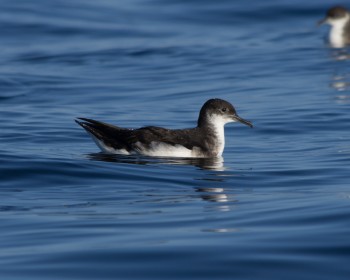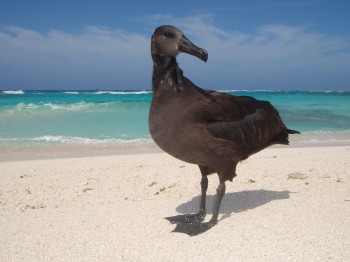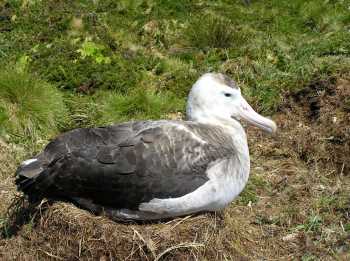Last month ACAP Latest News reported that New Zealand invasive species expert John Parkes was to undertake a feasibility study for the eradication of House Mice Mus musculus on South Africa’s Marion Island in the southern Indian Ocean during the annual relief of the island’s meteorological and research station (click here). John recently returned from the island on the annual relief after completimg his study and has replied to five questions put to him by ALN on his impressions of Marion and of the task ahead.
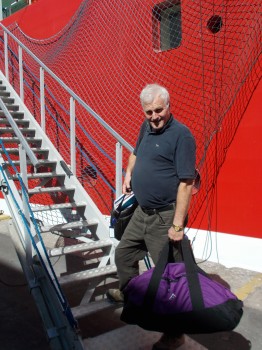
John Parkes heads south for the feasibility study
How was the field work?
It was of course great to see the island - and the mice. I was interested to see if there were mice up in the high-altitude 'polar desert' and confirmed their presence there, which means the whole island will need to be baited. It was very useful to talk to members of the scientific and meteorological staff present on the island. The photos of mouse-attacked Grey-headed Albatrosses Thalassarche chrysostoma by Ben Dilley and Peter Ryan of the FitzPatrick Institute, University of Cape Town reinforce the case already made by Andrea Angel and John Cooper in their 2011 report that the mice need to be eradicated.
Is eradication feasible?
Yes, the mice can be eradicated. Mice have been eradicated from 60 islands around the World including several sub-Antarctic islands such as Macquarie, Enderby and Coal Islands.
Confidence that it is possible on Marion will be improved if the recent attempt on parts of South Georgia (Islas Georgias del Sur)* prove successful and if the intended eradications on Antipodes, Gough and Steeple Jason, Falkland Islands (Islas Malvinas)* succeed. In fact of the 20 mouse eradication attempts made on islands since 2007 around the World only one has failed - probably due to reinvasion. This is a great improvement on attempts made before 2007 - when about a third had failed.
Are their research needs prior to an eradication attempt?
Several questions need to be answered for Marion. A major question is what time of year should an eradication attempt be made. Tradition has it that winter is the best time to undertake rodent eradications on temperate islands because the rodents are then at their hungriest and are not breeding. But winter on Marion has short days, many days on which helicopters cannot fly, and although the mice are not breeding and their numbers are reducing from their autumn peak densities, the per capita food supply may actually be better for the survivors than when they have to compete with lots of their fellows.
So a question to be resolved is whether a late summer - early autumn baiting might be better, as was the case for Enderby Island and for South Georgia (Islas Georgias del Sur)*. Some traditional bait-acceptance trials might be conducted in April during an annual relief. These use non-toxic bait marked with a dye that is spread in an area where mice have been trapped and tagged. They are then retrapped after baiting to see if 100% have eaten baits.
How did you find the quarantine procedures?
The South Africans take biosecurity seriously and try to stop new plants and animals arriving on their islands. However, if mice are finally eradicated from Marion the effort required to make sure they (or rats) do not get back needs some further thought. Current early detection-rapid response procedures at sites where supplies are unloaded from containers and nets on the island seem adequate for invertebrates, but what would the staff do if a mouse hopped out of an opened container ashore post-eradication? The risks of such events occurring are low, but the responses in place to stop a hitch-hiking mouse from scuttling off into the wild require some extra effort.
What were your overall impressions?
A fascinating place - few species of native plants but great to see the seals and birds. The Wandering Albatross Diomedea exulans has to be my favourite bird! South Africa has very few islands but the Prince Edward group must be the gem.
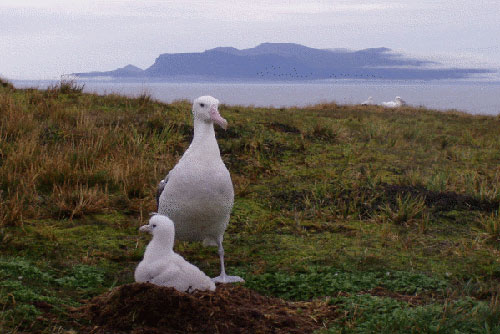
Wandering Albatross and chick on Marion Island, with mouse-free Prince Edward in the background 17 km away
Selected Literature:
Angel, A. & Cooper, J. 2011. Review of the Impacts of the House Mouse Mus musculus on sub-Antarctic Marion Island, Prince Edward Islands. Report to the Prince Edward Islands Management Committee, South African National Antarctic Programme. Rondebosch: CORE Initiatives. 57 pp.
Angel, A., Wanless, R.M. & Cooper, J. 2008. Review of impacts of the introduced House Mouse on islands in the Southern Ocean: are mice equivalent to rats? Biological Invasions 11: 1743-1754.
Jones, M.G.W. & Ryan, P.G. 2010. Evidence of mouse attacks on albatross chicks on sub-Antarctic Marion Island. Antarctic Science 22: 39-42.
Parkes, J. 2008. A feasibility study for the eradication of House Mice from Gough Island. RSPB Research Report No. 34. Sandy: Royal Society for the Protection of Birds. 51 pp.
Wanless, R.M., Cooper, J., Slabber, M.J. & Ryan, P.G. 2010. Risk assessment of birds foraging terrestrially at Marion and Gough Islands to primary and secondary poisoning. Wildlife Research 37: 524-530.
John Cooper, ACAP Information Officer, 28 May 2015
*A dispute exists between the Governments of Argentina and the United Kingdom of Great Britain and Northern Ireland concerning sovereignty over the Falkland Islands (Islas Malvinas), South Georgia and the South Sandwich Islands (Islas Georgias del Sur y Islas Sandwich del Sur) and the surrounding maritime areas.
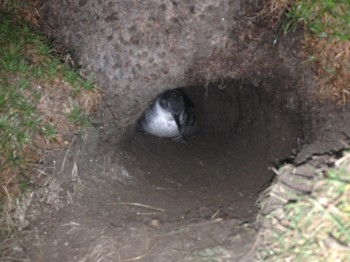

 English
English  Français
Français  Español
Español 